SCB-68 and SCB-68A : DAQ Multifunction I/O Accessory Guide
Overview
Contents
- Using this DAQ Accessory Guide
- Differences and Similarities between with SCB-68 and SCB-68A
- Quick Specifications, Manuals, Quick Reference Labels, and Dimensional Drawings
- Wiring Your SCB-68 or SCB-68A Terminal Block
- Understanding Feedthrough Modes and the DIP Switches
- Mounting your SCB-68A
- Compatible Devices, Modules, and Cabling for the SCB-68 and SCB-68A
- Additional Resources
Using this DAQ Accessory Guide
This guide is intended to cover the SCB-68 and SCB-68A 68-pin terminal blocks which are designed for use with NI DAQ devices. It does not cover the similar SCB-68 HSDIO terminal block.
- To find more information about other NI DAQ accessories and general information that applies to all DAQ accessories, visit DAQ Multifunction I/O Accessory Guide Main Page.
- To determine compatibility of your SCB-68 and SCB-68A with your NI DAQ device or module, or your NI DAQ cable, visit DAQ Multifunction I/O Cable and Accessory Compatibility.
- To create your own cable or test fixture, or to repair an NI DAQ cable or accessory, visit NI DAQ Device Custom Cables, Replacement Connectors, and Screws. First, note the connector information found on this page.
Differences and Similarities between with SCB-68 and SCB-68A
The SCB-68A, introduced in 2012, succeeded the popular SCB-68. The SCB-68A is recommended for all new designs. Both are 68-pin terminal block breakout accessories allowing wiring connectivity through screw terminals. Both blocks are functionally equivalent, with some improvements and small changes to the SCB-68A. The SCB-68A can be used as a direct replacement for the SCB-68.
| SCB-68A | SCB-68 |
|---|---|
| Provides a direct breakout of the terminals on the DAQ device or module, using screw terminal connections. | |
| Upgraded design: magnetic lid, updated styling, and updated blue/silver color scheme. | Original design: hinged lid and off-white color scheme. |
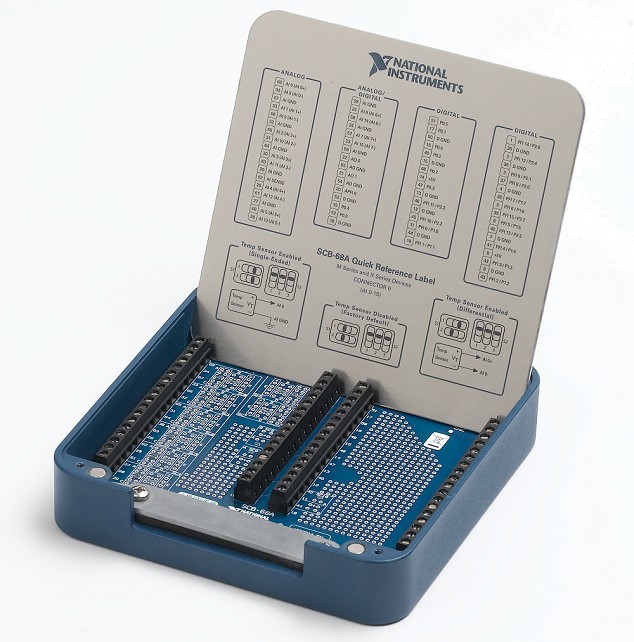 | 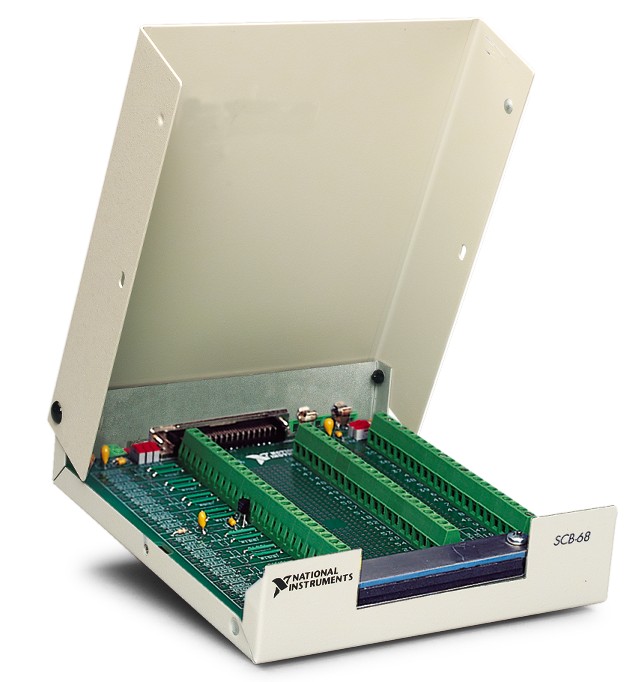 |
| Smaller breadboard area, different screw terminal and DIP switch locations. | Larger breadboard area, different screw terminal and DIP switch locations. |
| Same feedthrough modes, but different switch configuration. Refer to the DIP Switches and Feedthrough Modes section. | |
| Panel and wall mounting and DIN rail mounting options. | No panel, wall, or DIN rail mounting options. |
| Self-resetting fuse, refer to Quick Specifications. | User-replaceable fuse, refer to Quick Specifications. |
| Compatible with the same cables, devices, and modules. | |
| Features cold junction compensation (CJC) for accurate thermocouple temperature measurements. | |
| Visually similar to SCB-68 HSDIO, but functionally incompatible. | — |
Quick Specifications, Manuals, Quick Reference Labels, and Dimensional Drawings
This section contains a summary of information frequently sought when installing, wiring up or configuring the SCB-68 or SCB-68A. More detailed information can be found in the linked additional resources below. Dimensional drawings can be downloaded for free and are available in 2D and 3D formats; they contain size measurements and other helpful information, and are available in several popular formats, such as PDF, AutoCAD (.dxf, and .igs (IGES)), STEP (.stp), and .prt (Pro/E). Model-specific reference labels are provided for many popular DAQ families; they can be printed and attached to your terminal block for quick wiring reference.
| SCB-68A Quick Specifications and Published Resources |
|---|
| Connector and Pinout Information |

|
| Physical Characteristics | |
|---|---|
| Width | 14.7 cm (5.8 in.) |
| Depth | 14.7 cm (5.8 in.) |
| Height | 3.0 cm (1.2 in.) |
| Weight | 644 g (1 lb 7 oz) |
| For more information, refer to the User Manual and Specifications or Dimensional Drawing | |
| Screw Terminal Wiring Specifications | |
|---|---|
| Minimum wire gauge | 30 AWG |
| Maximum wire gauge | 14 AWG |
| Screw terminal torque | 0.5 to 0.6 N-m (4 to 5 in.⋅lb) |
| Spacing between screw terminals | 5.00 mm (0.19685 in.) |
| For more information, refer to the User Manual and Specifications | |
| Fuse Replacement Information | |
|---|---|
| Specifications | 1.10 A, 8 VDC, Self-Resetting, Not user replaceable. |
| For more information, refer to the User Manual and Specifications | |
| SCB-68 Quick Specifications and Published Resources |
|---|
| Connector and Pinout Information |

|
| Physical Characteristics | |
|---|---|
| Width | 18.1 cm (7.1 in.) |
| Depth | 15.2 cm (6.0 in.) |
| Height | 4.5 cm (1.8 in.) |
| Weight | 828 g (1 lb 13 oz) |
| For more information, refer to the User Manual for Advanced Functions or Dimensional Drawing | |
| Screw Terminal Wiring Specifications | |
|---|---|
| Minimum wire gauge | 30 AWG |
| Maximum wire gauge | 14 AWG |
| Screw terminal torque | 0.5 to 0.6 N-m (4 to 5 in.⋅lb) |
| Spacing between screw terminals | 5.00 mm (0.19685 in.) |
| For more information, refer to the User Manual for Advanced Functions | |
| Fuse Replacement Information | |
|---|---|
| Specifications | 800 mA, 250 VDC, Fast Blow |
| Size | 5 mm x 20 mm |
| Manufacturer | Littelfuse P/N 235.800 (or equivalent). Example. |
| For more information, refer to the User Manual for Advanced Functions | |
Wiring Your SCB-68 or SCB-68A Terminal Block
To easily wire sensors and signals to your terminal block, leverage the published documentation and information in this guide. Here are the basic steps to designing your measurement circuit diagram, understanding pin mapping, connecting your wiring, and configuring your terminal block. Failure to set up your terminal block properly may lead to no readings, unexpected readings, noisy readings, or possible damage to your terminal block, device, or module.
- The general concepts of pin mapping and pinouts are covered in the DAQ Accessory Guide Main Page. Note, a common point of confusion for normal wiring is the need to first understand the cable mapping, or pinout at the connector found on your terminal block, which is not the case.
- The User Manuals, User Guides, and Quick Reference Labels for the SCB-68 and SCB-68A are provided in the Quick Specifications and Published Resources section above. These contain pinout or pin mappings, and also extended information for configuring your terminal block in the various modes that it supports, extending its functionality, and noise reduction, as described below.
- A common issue with analog signals is noisy or floating signals, even when using a shielded connector block. These can be avoided by first understanding your measurement type, and creating a circuit diagram that allows you to wire and then ground your signals correctly.
- Review Field Wiring and Noise Considerations for Analog Signals. This guide contains extended information on noise reduction, and how to correctly wire differential (DIFF), Ground Referenced Single-Ended (RSE), and Nonreferenced Single-Ended(NRSE) measurement modes for floating signal sources and grounded signal sources.
- Common issues with thermocouple temperature readings are typically due to incorrect DIP switch settings, understanding the cold junction compensation (CJC), understanding open thermocouple detection, and thermocouple input filtering.
- It is also important to consider using shielded signal wires, shielded cables, and ensuring that the terminal block itself has been correctly grounded.
- The breadboard on your SCB-68 and SCB-68A can be used to add custom circuitry. You may also need to install bias resistors, lowpass filtering, highpass filtering, resistors for current input measurement, voltage attenuation or division, and more. The user guides and user manuals referenced in this guide contain detailed information on when to do these setups, how to configure them, and other details such as soldering and desoldering information.
- Once you've completed your wiring, make sure to finish by tightening the strain relief bar to ensure that your wires can not easily pull out from your terminal block.
Understanding Feedthrough Modes and the DIP Switches
Incorrectly setting the DIP switches and misunderstanding the feedthrough modes on your SCB-68 or SCB-68A can result in noisy readings, unexpected readings, or no readings at all. Further, if measuring thermocouples, understanding the onboard temperature sensor for cold junction compensation (CJC), and how to enable the various sensor modes is important to getting an accurate reading. Review your user manual, user guide, or Compatible Devices, Modules, and Cabling for more information about compatibility of your NI device or module with the various modes. The SCB-68 and SCB-68A user manuals contain more detailed information about each mode.
Common issues with the DIP switches typically arise if you previously used your terminal block with another device or module, or are switching to or from taking thermocouple measurements. Also, blown fuses often cause unexpected behaviors when using modes other than direct feedthrough.
Direct Feedthrough Mode
In this mode:
- All 68 signals from the device break out directly to the screw terminals.
- The onboard temperature sensor is not used.
- +5 V power is not provided to the signal conditioning area of the accessory.
Some supported devices and modules can only use this mode.
| SCB-68A | SCB-68 |
|---|---|
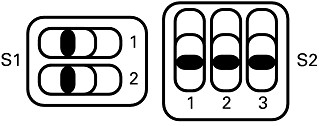 | 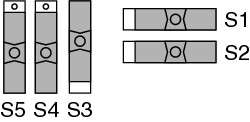 |
MIO with Disabled CJC Temperature Sensor Mode (Factory Default)
In this mode:
- The onboard temperature sensor is not used.
- All device/module analog input (AI) lines (including AI 0 and AI 8) are accessible at the screw terminals.
- +5 V power is provided to the signal conditioning area of the accessory.
| SCB-68A | SCB-68 |
|---|---|
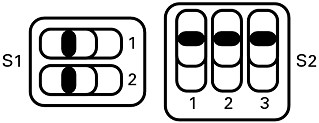 | 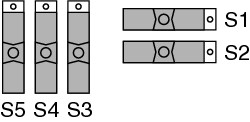 |
MIO with Single-Ended Temperature Sensor Mode
In this mode:
- The temperature sensor can be read using AI 0 in referenced single-ended (RSE) mode.
- All device/module analog input (AI) lines (except AI 0) are accessible at the screw terminals.
- +5 V power is provided to the signal conditioning area of the accessory.
| SCB-68A | SCB-68 |
|---|---|
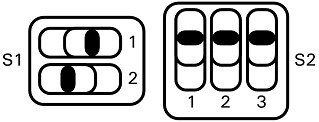 | 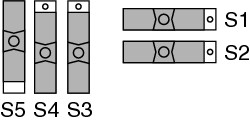 |
MIO with Differential Temperature Sensor Mode
In this mode:
- The temperature sensor can be read using AI 0 and AI 8 in differential mode.
- All device/module analog input (AI) lines (except AI 0 and AI 8) are accessible at the screw terminals.
- +5 V power is provided to the signal conditioning area of the accessory.
| SCB-68A | SCB-68 |
|---|---|
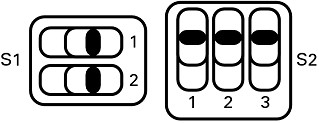 |  |
Mounting your SCB-68A
- DIN Rail Mounting - The NI 9913 DIN rail mounting kit (part number 781740-01) contains one clip for mounting the SCB-68A on a standard 35 mm DIN rail. Refer to the NI SCB-68A User Manual for more information.
- Panel or Wall Mounting - To panel or wall mount the NI SCB-68A, refer to the instructions in the NI SCB-68A User Manual. Without scaling or resizing, print the referenced Panel Mounting Template that corresponds with your paper format. Use the printout as your mounting template. Extended information can be found on the 2D drawings and the 3D models for the SCB-68A, and are available through the referenced Dimensional Drawings.
Note: The SCB-68 does not offer mounting options.
Compatible Devices, Modules, and Cabling for the SCB-68 and SCB-68A
Some devices and modules listed in the table have extended compatibility information, which is linked to in their Compatibility Guide. Refer to your device or module's user manual or user guide for more information.
Supported Features:
- All - All of the extended functionality that the SCB-68 and SCB-68A has to offer is supported, including: direct feedthrough mode, thermocouple measurements, open thermocouple detection, current input, filtering, and voltage dividers.
- Direct only - Direct feedthrough mode is the only supported mode. DIP Switches must be set to direct feedthrough mode, which is not the default mode.
| Device or Module | Supported Features | Shielded Cable | Unshielded Cable |
|---|---|---|---|
| NI DAQ Models (NI 6xxx) | |||
| NI 60xxE (formerly E Series) 68-pin DAQCard Models | All1 | See Compatibility Guide | |
| NI 60xxE (formerly E Series) 68-pin PCI/PXI/DAQPad Models | All1 | See Compatibility Guide | |
| NI 60xxE (formerly E Series) 100-pin Models | All1 | See Compatibility Guide | |
| NI 61xx Models (formerly S Series) | All1 | See Compatibility Guide | |
| NI 62xx Models (formerly M Series) | All1 | See Compatibility Guide | |
| NI 63xx Models (formerly X Series) | All1 | See Compatibility Guide | |
| NI 66xx Models (formerly Timing I/O [TIO] Series) | Direct Only2 | See Compatibility Guide | |
| NI 67xx Models (formerly Analog Output [AO] Series) | Direct Only2 | See Compatibility Guide | |
| NI SC Express Models (PXIe-43xx) | |||
| NI 4309 | Direct Only2 | SHC68-68-EPM | N/A |
| NI High Speed Digital I/O (HSDIO) or Digital Instruments (NI 653x) | |||
| NI 6533/6534 Legacy High-Speed Digital I/O (HSDIO) | Direct Only2 | See Compatibility Guide | |
| NI Legacy High-Speed Digital I/O (HSDIO) 68-Pin DAQCard Devices | Direct Only2 | PSHR68-683 | PR68-68F3 |
| NI Switches Models (NI 25xx) | |||
| NI 2501/2503/2533/2534 | Direct Only2 | SH68-68-S | R68-68 |
| NI R Series Models (NI 78xxR) | |||
| NI 7830R/7831R/7833R (Connector 0) NI 7841R/7842R/7851R/7852R (Connector 0) USB-7845R/7846R/7855R/7856R (Connector 1) PXIe-7846R/7847R/7856R/7857R/7858R (Connector 0) NI 7853R/7854R (Connector 0) PXIe-7867R/7868R (Connectors 0 and 2) | Direct Only2 | See Compatibility Guide | |
| NI 7811R/7813R (All connectors) NI 7830R/7831R/7833R (Connectors 1 and 2) NI 7841R/7842R/7851R/7852R (Connectors 1 and 2) NI 7853R/7854R (Connectors 1 and 2) | Direct Only2 | See Compatibility Guide | |
1Refer to Known Limitations notes, below for special limitations with certain devices and modules.
2Refer to notes on using devices and modules supporting Direct Only, below.
3These cables are no longer available for purchase from NI.
Known Limitations
If the DIP switches are not set to the correct modes, you may experience incorrect or unexpected readings, blown fuses, or damage your accessory:
- The following devices and modules only support direct feedthrough mode in the noted configurations:
- NI 6025E when connected to Connector 1.
- NI 6031E, NI 6033E, NI 6071E 100-pin models when connected with the SH1006868 cable, unless external power is provided.
- NI 6225 and NI 6255 models when connected to Connector 1.
- NI 6345, NI 6346, NI 6349, NI 6355, NI 6365, NI 6375 models when connected to Connector 1, Connector 2 (if equipped), or Connector 3 (if equipped).
- MIO with single-ended temperature sensor mode is not available on the following devices and modules:
- All NI 61xx (formerly S Series) DAQ devices and modules.
- NI 63xx (formerly X Series) simultaneous sampling devices and modules (NI 6346, NI 6349, NI 6356, NI 6358, NI 6366, NI 6368, NI 6376, NI 6378).
- The SCB-68 and SCB-68A ship with the DIP Switches set to MIO with disabled CJC temperature sensor mode. Devices and modules only supporting direct feedthrough mode must change this DIP switch configuration to ensure correct performance.
Additional Resources
Documentation
- Learn about specifications, model differences and other common questions for other DAQ accessories.
- Learn about cables used with the SCB-68, SCB-68A, and other DAQ devices, modules and accessories.
- Learn about the compatibility of NI DAQ devices and modules with NI DAQ cables and accessories.
- Find the parts needed to make a custom cable, breakout fixture, or replace connectors and screws on NI DAQ hardware.
- Browse dimensional drawings for NI DAQ cables and accessories.